Whether you know them as corydoras, corys, or cory cats, odds are you’ve admired these little catfish in the pet store at some point in your aquarium hunt.
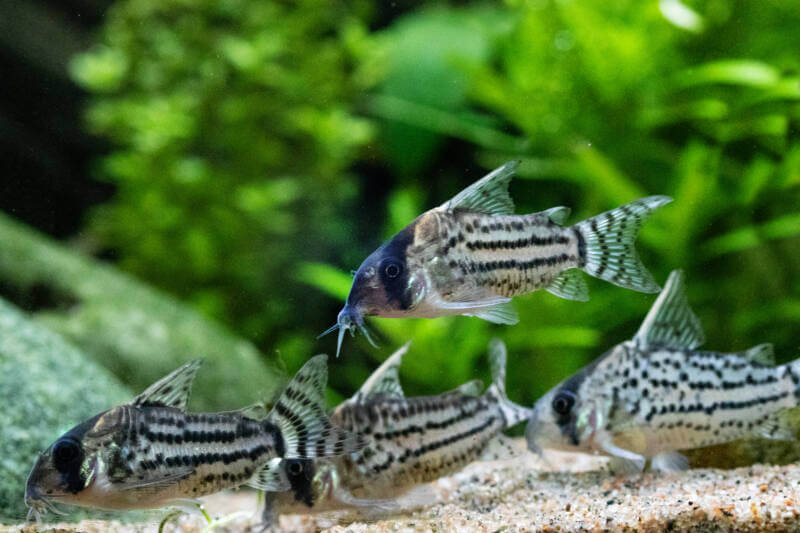
The wide-eyed catfish have an adorable appearance that endears them to aquarists of all ages.
The Corydoras genus currently counts 170 members, with more surfacing all the time.
Some of the newest lack names, sporting a “C” and a number instead.
Their range of colors and patterns, combined with a sweet temper, makes them the perfect addition to a community tank.
Whether a beginner or master aquarist, corys offer minimal difficulty. So long as you’re on top of your water quality, your corys will handle most situations without a problem.
As a matter of fact, it’s you and the other fish that could face problems if you’re not careful!
At a Glance
| Min tank size: | 20 gal (80 l) |
| School size: | minimum of two (six is better) |
| Temperature: | 72-78°F (22-26°C) |
| Lifespan: | up to 5 years |
| Size: | 1-4 inches (2.5-10 cm) |
| pH: | 7.0-7.8 |
| Hardness: | 3-10 dH |
| Ammonia: | 0 ppm |
| Nitrite: | 0 ppm |
| Nitrate: | <20 ppm |
[toc]
Corys: In the Wild
Corydoras frequent slow-moving waters in South America, everywhere between the Atlantic Ocean and the Andes.
They prefer clear waters with plenty of plants for hiding places. Overhanging plant cover keeps them safe from the sun and predators.
The most popular tetras, including the neon tetra, often frequent the same warm waters as corys.
Cory cats inhabit the sandy bottoms of the streams and rivers while the tetras school overhead.
Unlike the nocturnal plecostomus, corys are diurnal and scavenge for food during daylight hours.
Corydoras have an adaptation to their intestinal lining that allows them to “gulp” oxygen from the surface. This evolution keeps them healthy in low-oxygen conditions.
People often hear a “popping” sound when their corys swim to the surface and then dart back to the substrate.
Some cory species also have an adaptation of venom. When stressed, they release the toxin throughout the water.
The venom can cause skin reactions to humans and prove fatal to other fish in an aquarium. (Which is why you want your corys to remain happy and healthy)
Popular Types of Corydoras
1. Agassizi Cory (Corydoras agassizii)

Many corys have black and silver patterns, but not quite as stunning as that seen on the Agassizi cory.
Also called the spotted cory, the splotches of black break up across the body and tail, glowing against their silver scales and near-transparent fins.
2. Bronze Cory (Corydoras aeneus)
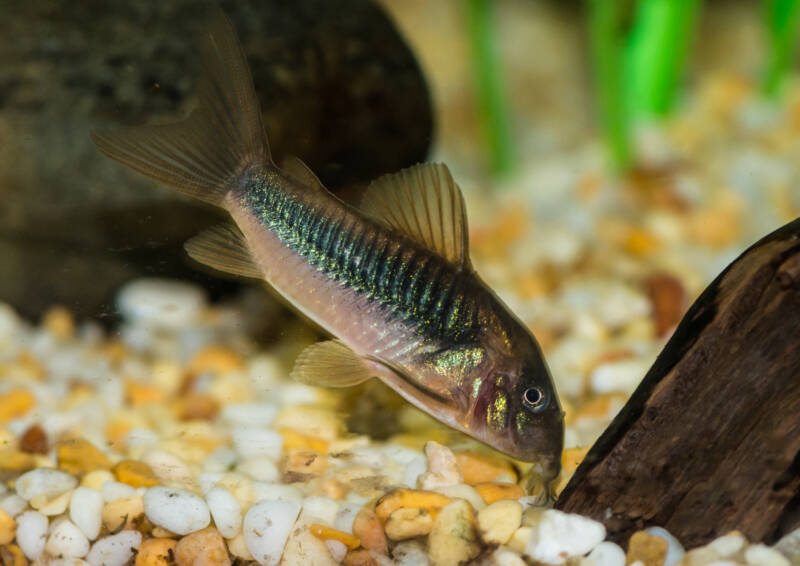
Bronze corys rank as some of the most popular cory cats. They’re available in multiple color varieties, despite their name.
Just avoid any you see with bright, dyed colors – this practice impacts their health and lifespan.
3. Flagtail Cory (Corydoras robineae)
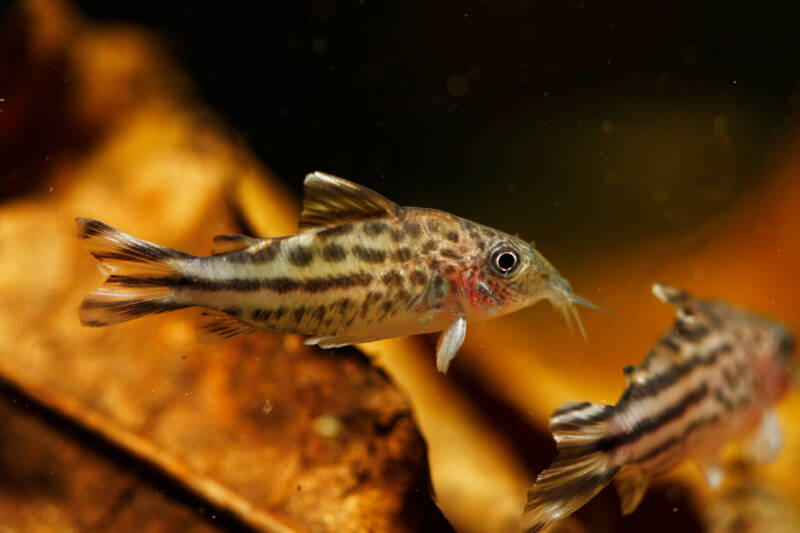
Flagtail corys aren’t as shy as some of the other cory cats. With the striking black and white markings on their tails, they enjoy staying out where you can watch their shoaling antics.
4. Julii Cory (Corydoras julii)
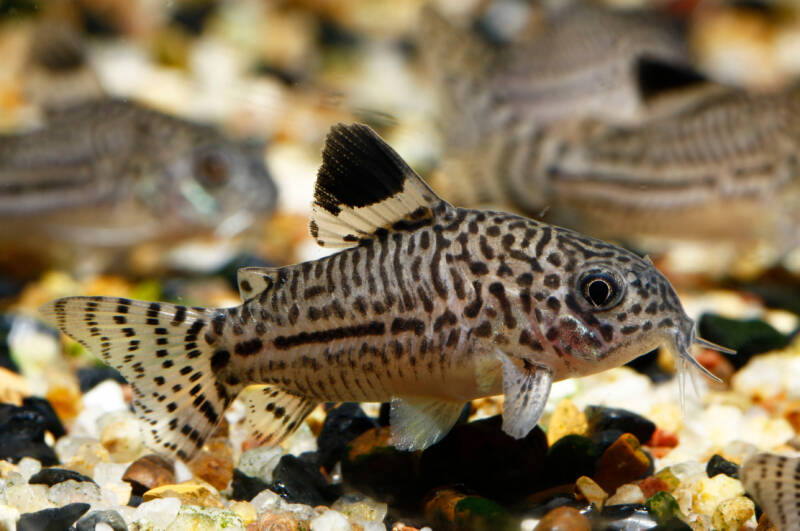
Aquarists often mistake Julii corys for three-lined corys. Julii’s feature spots along their sides – dots that DON’T connect into stripes.
This makes them easy to tell apart from the three-lined cory, which often gets mislabeled with the Julii name.
5. Burgess’ Cory (Corydoras burgessi)
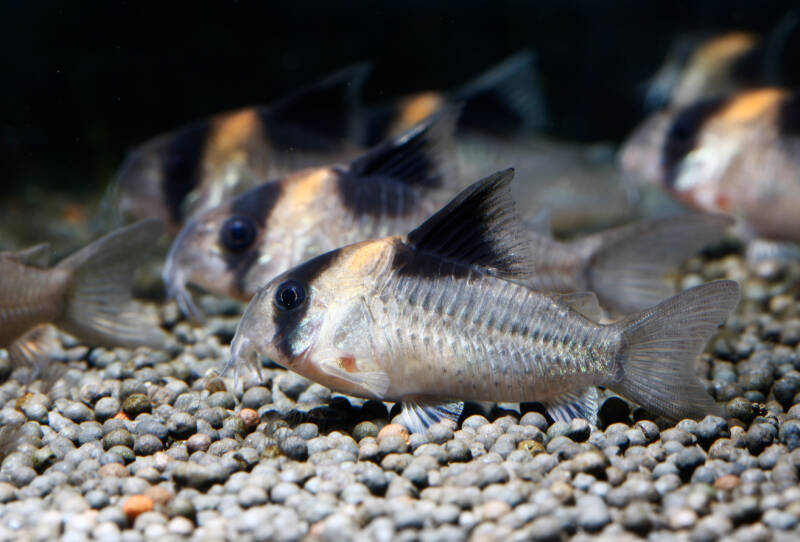
Orange blotch corys – also known as Burgess’ cory – may not have the most exciting name, but the iconic orange spot on their neck stands out in the right lighting.
In the wild, the spot helps the members of the school stick together in murky waters.
6. Pepper Cory (Corydoras paleatus)
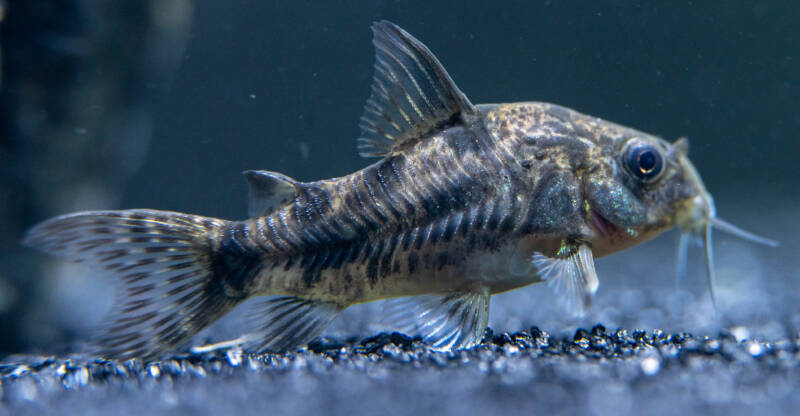
Pepper corys share the spotlight with bronze cory cats. Aquarists love the “winking” habit of these little catfish – a habit from their articulated eyes.
No two pepper corys have the same pattern of splotches, making for a unique tank look.
7. Pygmy Cory (Corydoras pygmaeus)
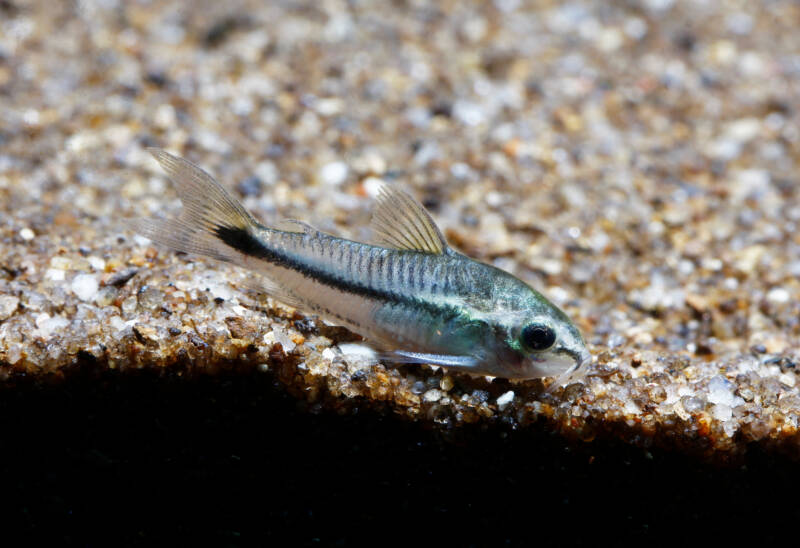
For fans of nano aquariums, the pygmy cory fits the bill. With an adult length of just 1 inch (2.5 cm), you can manage an entire shoal in the smallest tank.
However, they stress easily due to their tiny size, so take extra care.
8. Salt and pepper Cory (Corydoras habrosus)
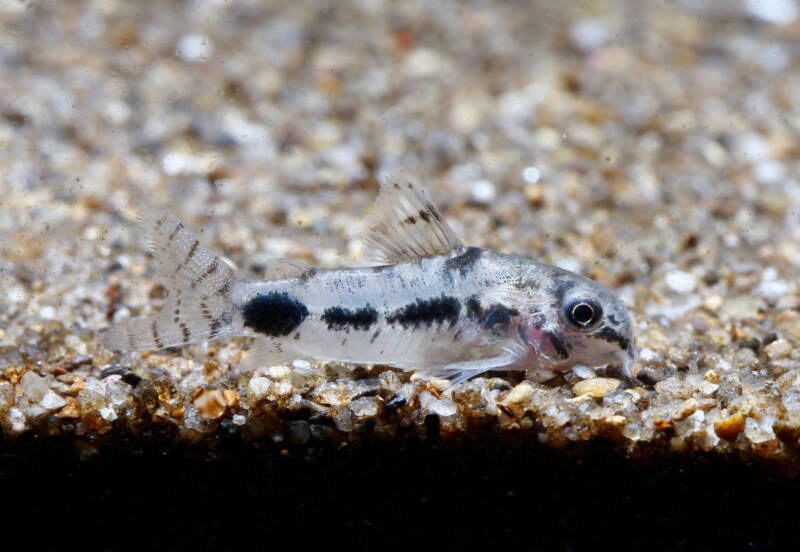
The salt and pepper cory falls into the category of dwarf cory cat. Unlike most corys, they hover just above the bottom in their shoals.
And the more you group together, the happier they are. (Good thing they’re tiny!)
9. Schwartz’s Cory (Corydoras schwartzi)

For those looking for a rarer member of the cory cat group, you can’t go wrong with Schwartz’s cory.
You’ll likely end up with a wild-caught import you’ll need to fatten up a bit, as commercial-breeding isn’t quite up on this species just yet.
10. Skunk Cory (Corydoras arcuatus)

Named for the prominent stripe down their backs, skunk or arched corys present a challenge for aquarists.
These corys are extremely sensitive to nitrites and nitrates, even more so than other corys.
Make sure your tank’s fully mature before adding them.
11. Sterba’s Cory (Corydoras sterbai)
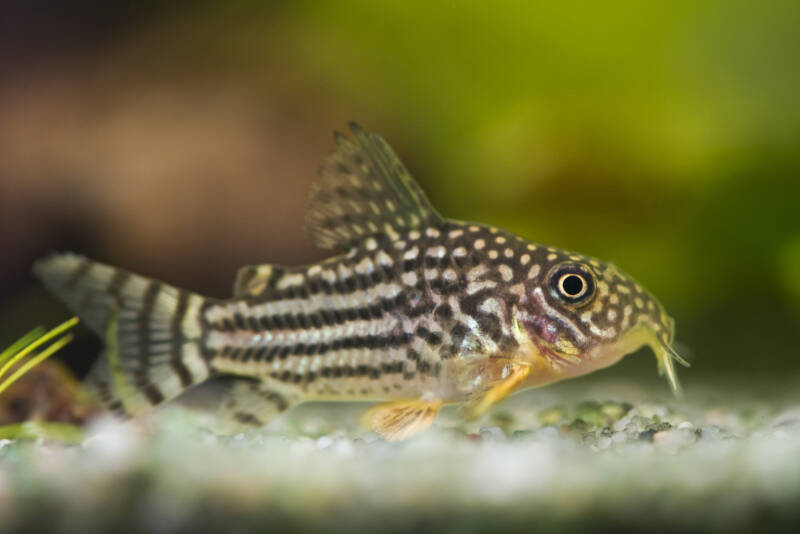
You may have to hunt for Sterba’s cory a bit, but it actually ranks as one of the most popular species.
They’re simple to breed, so most aquarists acquire them from captive-breeding instead of the Mato Grasso region of Brazil.
12. Tailspot Cory (Corydoras caudimaculatus)
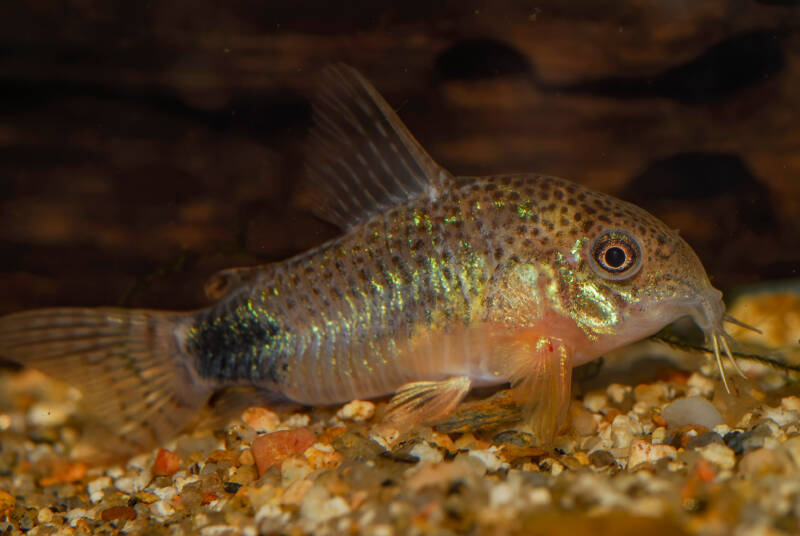
If you have a little more experience under your belt, the tailspot cory makes a challenging addition to a community tank.
Named for the dark splotch near their tail, these little cory cats are some of the most difficult to breed.
13. Three-lined Cory (Corydoras trilineatus)
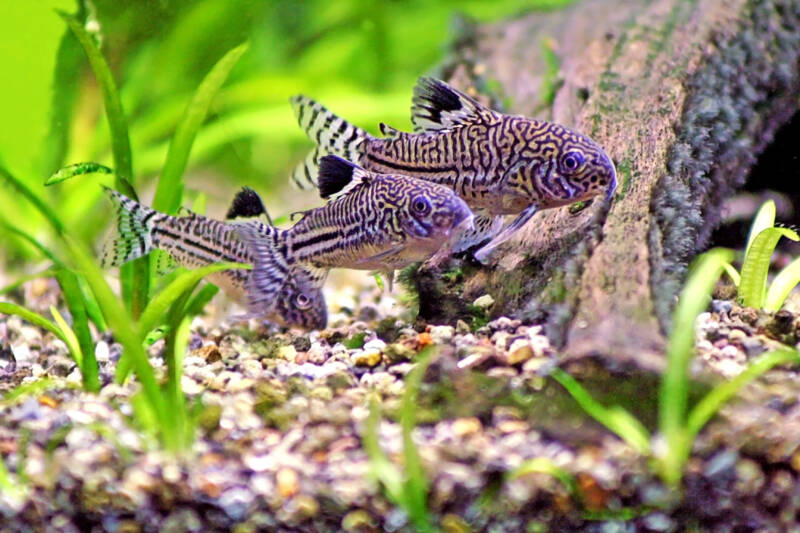
People often confuse the three-lined cory for the Julii cory. Which is why it’s also called the false Julii cory.
In addition to their stripes, you can tell the two species apart by their head spots, which connect back to those distinguishing stripes.
14. Panda Cory (Corydoras panda)
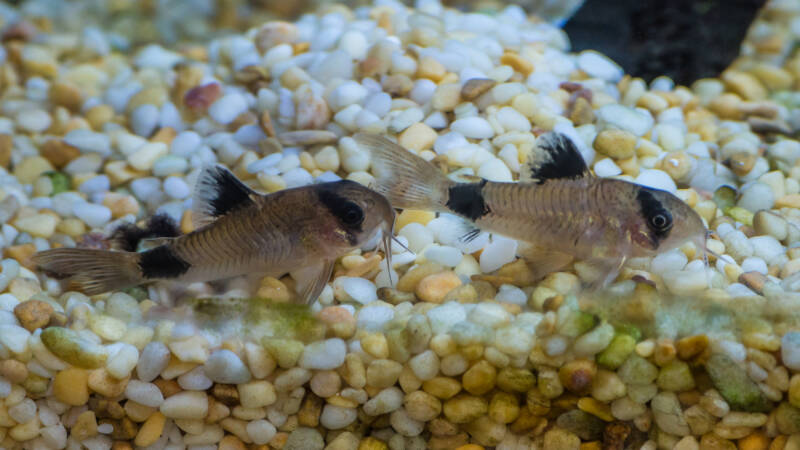
Cute and Compact Catfish
Aquarists enjoy keeping corys due to their small size. Most corys rarely get larger than 2.5 inches (6.4 cm).
They’re on the narrow side, too – about the width of a dime or nickel. With particularly large eyes, these minuscule catfish have a large fanbase.
The more nano-species rarely grow larger than 1 inch (2.5 cm) as adults. At the other end of the spectrum, you won’t find cory cats reaching more than 4 inches (10 cm).
This manageable size allows you to keep a healthy school without needing a monstrous tank.
Lifespan
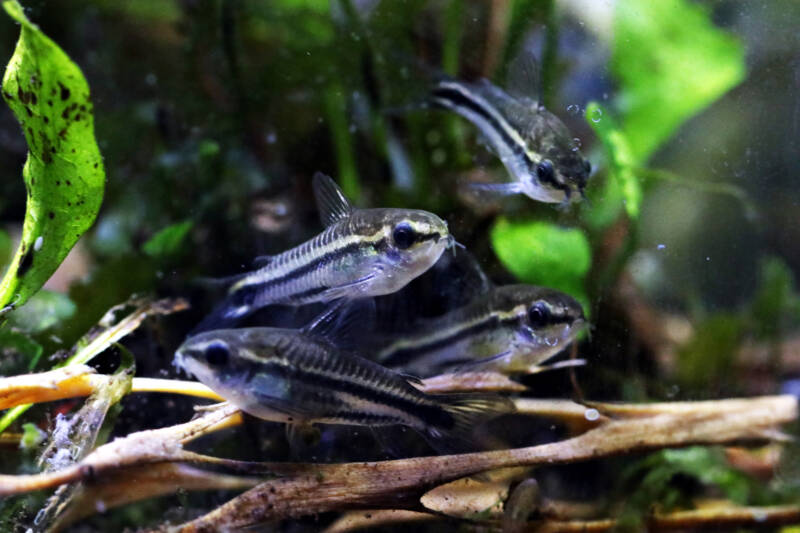
Overall, corydoras rank as one of the hardiest freshwater fish on the market.
Despite their diminutive size, they live for about 5 years. That assumes you keep them under the best conditions, though, and that they survive transport from the pet store or breeder.
Dramatic shifts in water conditions produce sudden shocks to cory cats. This often causes these delicate little catfish to die shortly after the introduction to a new community tank.
To increase your chances of success, transport them in individual bags, and allow plenty of time to adjust.
Behavior

Unlike some catfish, corys enjoy a healthy social life. In the wild, they swim in synchronized patterns in schools of up TWENTY.
Aquarists have even seen them joining in with some of the tetra schools in their native regions.
You CAN keep a single cory in a tank, but you won’t see the same activity level. Odds are, your little cory cat will adopt itself into one of the other schools in your community aquarium to boost its morale.
A minimum of two corys works best, but if you can manage six, that’s the ideal number.
The shoaling members rarely drift more than an inch (2.5 cm) from each other, even when taking a break during their resting hours. You’ll get a more dynamic aquarium with higher numbers.
Tank Setup
In theory, a 10-gallon (38 l) aquarium works fine for the tiniest cory cats.
However, if you want to keep a happy, healthy school, your best bet is to go no smaller than 20 gallons (76 l).
For every additional cory you add beyond that, add 3 extra gallons (7.5 l).
Corydoras naturally dart to the surface to gulp oxygen. If you see your corys performing this behavior frequently, consider adding air stones or extra plants to boost your tank’s oxygen levels.
Otherwise, a standard HOB filter provides enough water flow.
Water Conditions
Cory cats enjoy tropical water conditions. You don’t want to see the water temperature drop out of the 72 – 78°F (22 – 26°C) range.
You should also try to keep the water as neutral as possible. In the wild, they enjoy a pH of 7.0 – 7.8.
Similar to tetras, corys inhabit the softer waters of the Amazon basins. As such, try to keep your tank’s water hardness around 3-10 dH.
Unlike some tetra species, though, you don’t need to worry about adding tannins to the water – they prefer the aquarium water to stay clear.
Cory cats are particularly sensitive to nitrates. You want to aim for 0 ppm as much as possible.
If you start to get above 20 ppm, you’ll see white patches developing around your corys’ barbels and mouths. Without treatment, they’ll stop eating and eventually starve to death.
Decorating the Corydoras Tank
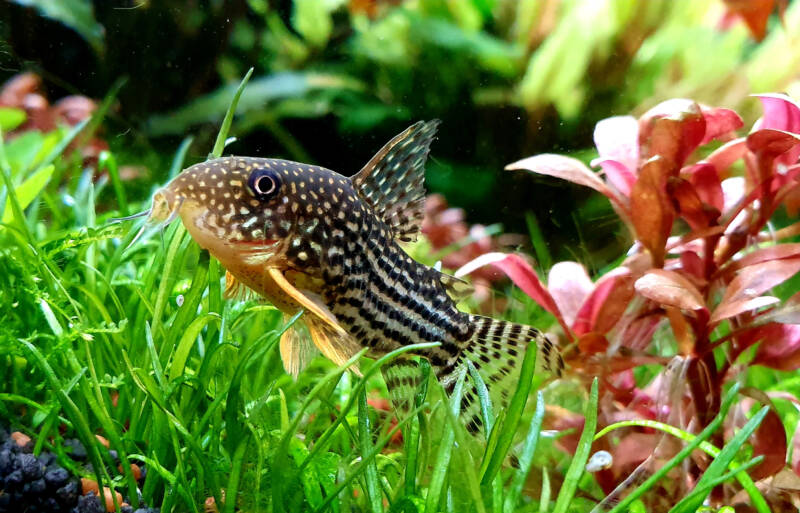
Many aquarists worry over damaging those delicate catfish barbels. As such, they avoid using gravel in their tanks.
In the wild, though, corydoras probe sharp substrates without a problem. If you see barbel problems, odds are the issue’s your water conditions, not the substrate.
If you’d prefer to stay on the safe side, sand works fine. Take care during cleaning, though.
You don’t want to stir up too much of the waste and bacteria that might have collected. Corys DO scavenge, but they can’t get everything, and you don’t want to make them sick.
Cory cats LOVE plants. They nibble the leaves and use the cover to hide in. Some of your best options include:
- Amazon sword
- Crypt
- Dwarf hairgrass
- Guppy grass
- Java fern
- Penny warts
Rocks make excellent decorations, but some decorations and rock caves present a unique problem for corys.
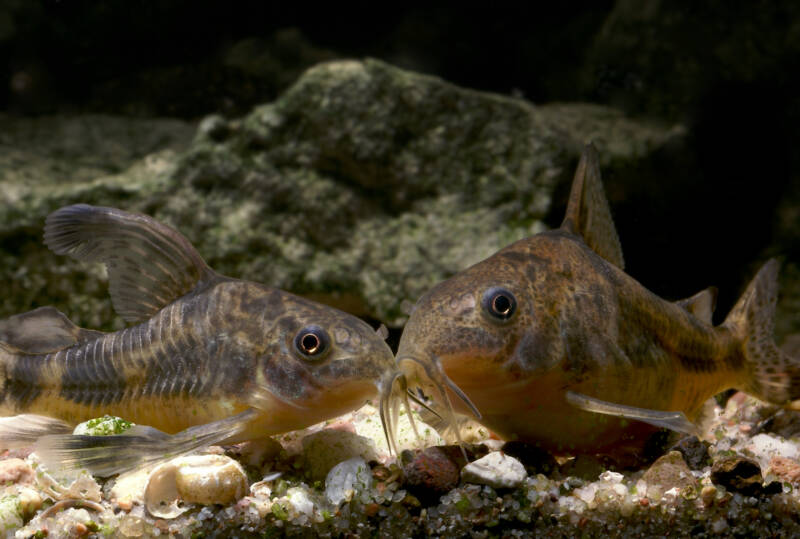
As shoaling fish, they have a “fright reflex.” When fleeing, these tiny catfish often get stuck in the rockwork.
If you opt for rock décor, choose pieces without holes small enough for your corys to get trapped inside.
Smooth, rounded rocks make the best options for cory tanks. Partially embed them in the sand, and your cory cats should stay safe.
Corydoras in Communities
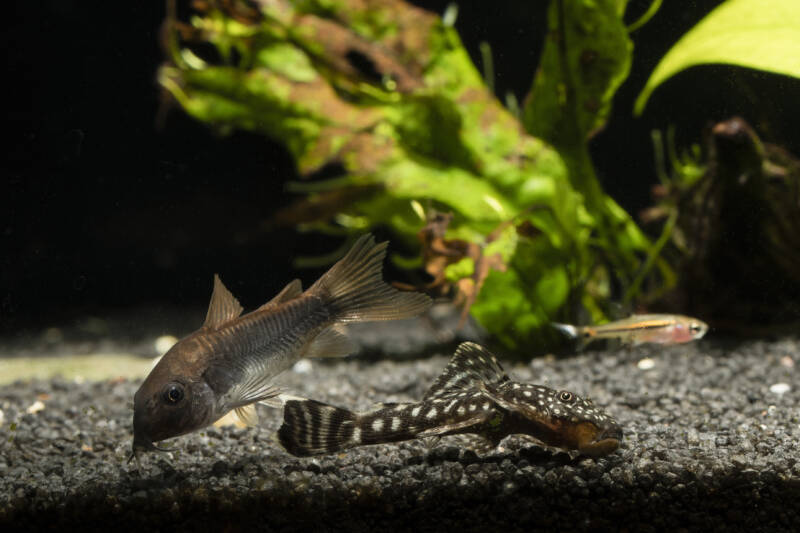
Aquarists love corydoras as they make perfect community tank additions. These little bottom-dwellers have peaceful temperaments, they’re active, and they move in coordinated patterns.
As long as you choose compatible fish, they get along well with almost anyone.
Tank Mates
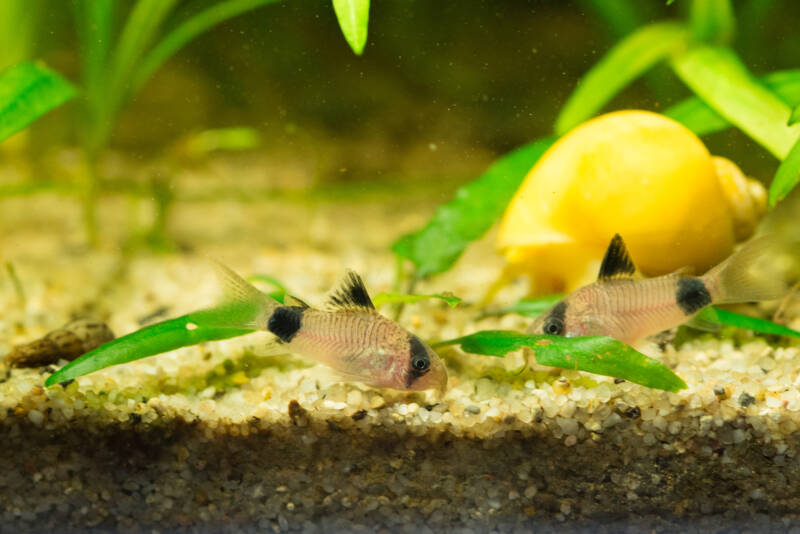
Due to their small size, cory cats work well in nano tanks and larger community aquariums.
They don’t harass freshwater shrimp or snails, pairing nicely in invertebrate tanks. And so long as you choose peaceful tank mates, you won’t have problems.
Other than an occasional jaunt to the surface for a “bite” of air, corys stay on the bottom.
So matching them with calm fish that prefer the middle or top of the aquarium works well. The best choices include:
- Guppies
- Mollies
- Otocinclus catfish
- Swordtails
- Tetras
Incompatible Species
Due to their tiny size, you should avoid pairing corydoras with any fish large enough to swallow them.
Even in a school, it’s possible to lose a cory cat to a tank mate. That armored exterior is no match for a large, aggressive fish.
The following fish make TERRIBLE tank mates for cory cats:
Feeding
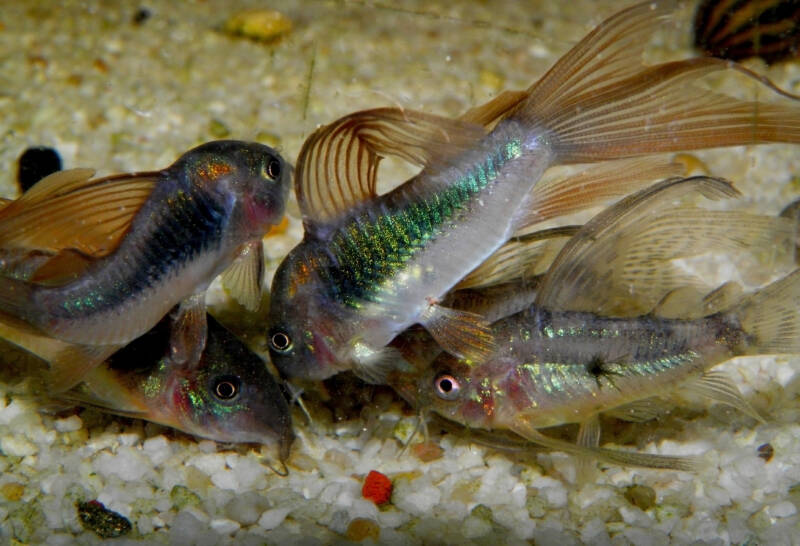
Corydoras are scavenging omnivores. They spend their waking hours probing the bottom with their barbels for leftover pieces of meals dropped by other fish in the tank.
They may sample algae here and there, but they aren’t strict algae-eaters in the way of other catfish.
However, unless your aquarium houses a lot of ill fish, your corys won’t find enough leftovers to stay healthy.
That means you’ll need to provide a once-a-day feeding to make up the difference, so your adorable little cory cats don’t starve.
Make sure the commercial diets you provide reach your corys on the bottom. They may travel to the surface for air, but they don’t feed up there.
Some great options that sink well include:
Corys also love worms of all kinds. You can switch between live and frozen options to provide the best variety in their diet.
Cory favorites include:
- Blackworms
- Bloodworms
Breeding Corydoras: Not so Difficult
Corydoras breed in home aquariums with little trouble. The problem comes with getting the eggs to survive to hatching.
See, corys enjoy eating fish eggs – including their own. So if you want baby cory cats, you’ll need a separate breeding tank.
Males or Females?
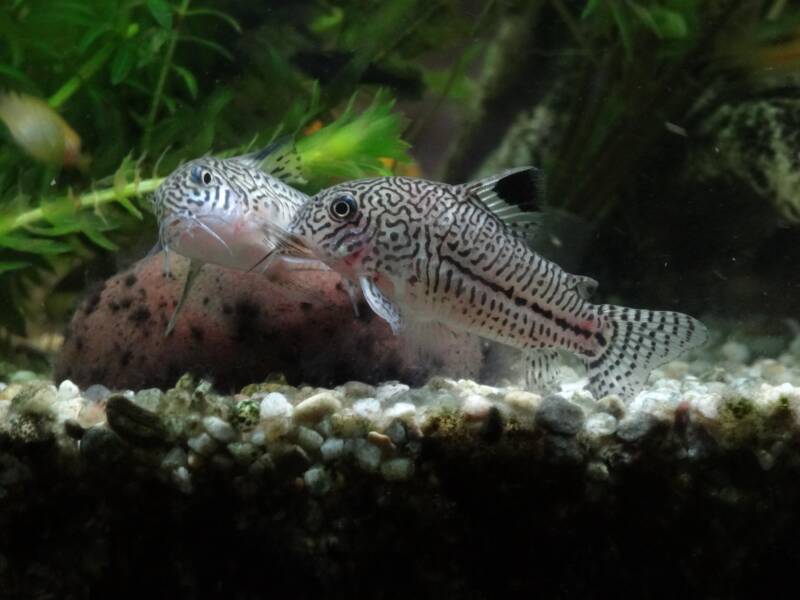
Unlike many freshwater fish, hoping to gauge males from females based on color or pattern brightness doesn’t work with corys.
Both sexes share the same vibrant shades throughout all stages of their lives.
Males tend toward the smaller size, though. They’re also thinner, especially when viewed from above.
If you look at their fins (not the caudal fin), you’ll see they’re a little more pointed than those found on the female.
The differences aren’t subtle, so sexing corys is easy.
Nests in the Sand
Breeding corys successfully requires a separate tank – for the eggs, if nothing else.
You’ll increase your chances if you place a breeding pair in a tank of their own, though. Just set up a partition so you can keep the parents away from the eggs.
Corydoras spawn during the rainy season. You can simulate this weather pattern by decreasing the water temperature by 5 degrees.
The cooler temperature reflects the sudden rainfall expected in the wild.
Females clear a spot in the sand for their nest. You’ll also notice the male hovering close by.
Sometimes more than one male fertilizes a nest, so consider placing two males per female in your breeding tank.
Cory cats lay around ten eggs in their nest. As soon as you see the eggs, scoot the adults to their side of the partition to prevent cannibalization.
The eggs hatch within six days. The fry survive on their yolk sac and then turn free-swimming. You can feed them on fry foods at that point.
Diseases
Corys have a hardy reputation. It makes them popular with aquarists of every level.
However, if you slip on your water changes, you’ll start seeing problems. Cory cats can fall ill, and cleaning the tank may not be enough to save them.
In addition to their nitrate sensitivity, corys fall victim to nitrite poisoning. Symptoms include lethargic behaviors and swimming higher in the tank.
Check your water values immediately. If your nitrites are above 0 ppm, you may need to consider one of the following options:
- Add nitrate/nitrite absorbers to your water.
- Increase the number of plants in the tank.
- Reduce the amounts of food.
- Cut back on the numbers of fish in your aquarium.
Corydoras: Are They for You?
The synchronized shoaling behavior of cory cats appeals to fish fanatics of every age.
The large eyes give these fish an adorable appearance as they probe along the substrate.
Ranging in price from $3-$30, even for the rarest species, they’re also not terrible in cost.
Cory Cats
For those that love fluttering activity at the bottom of their aquarium, you can’t go wrong with corydoras.
These cute little catfish add personality and colorful patterns to any community tank.
Just make sure you don’t add any fish large enough to swallow them!
Which corys are your favorites? How old is your oldest cory?
Have you heard the “popping” at the surface of your tank?
Ask your questions and share your stories here!
